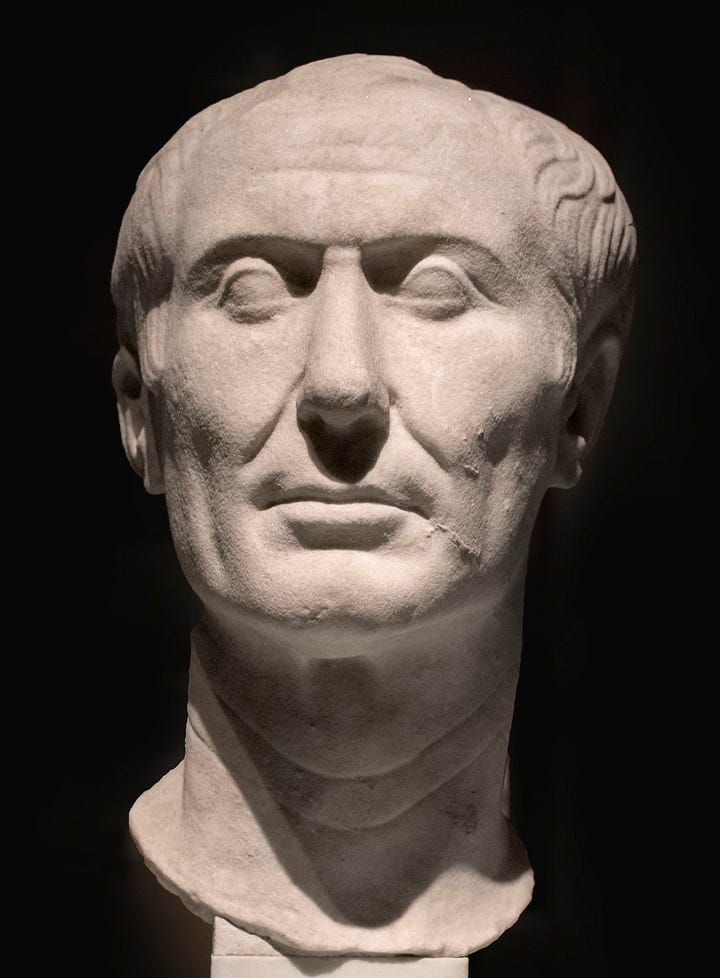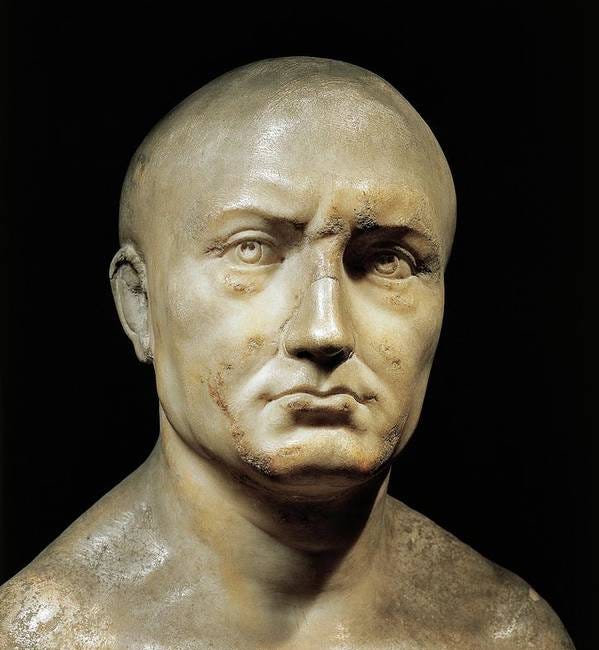A republic dies
Review of Rubicon: The Triumph and Tragedy of the Roman Republic by Tom Holland


This is a narrative panorama of one the great historical watersheds: the Roman Republic’s slide to destruction. Holland begins with the rivalry of Marius and Sulla. Marius took Sulla under his wing, training him and also abusing him. They became deadly enemies.
In the late 2nd century BCE, these two generals were operating during the period when Rome was expanding so rapidly that a new source of manpower had to be found: rather than exclusively rely on landowners, Marius began to enlist anyone who would serve. With nowhere to return to, the loyalties of the new recruits belonged more to their leader than to any idea of "The Republic" – they were not republican "citizens" who were land-owning farmers, a mythic, quasi-religious ideal. The consequences were extremely grave: when Sulla ordered them to attack Rome after Marius had out-maneuvered him politically, they obeyed, beginning a period of catastrophic instability at the moment that Rome was facing new pressures from several directions. Law no longer ruled, military power and personal loyalty did.
Holland also explains, in a clearer way than I have ever read, how The Republic was a combination of centuries-old custom, essentially of religious reverence. Citizens respected the institutions, which had proven resilient and adaptable for nearly 500 years, progressively expanding representation and reasonably just, at least for its citizens. While not a democracy as we understand it, neither was it a monarchy nor a pure aristocracy. Tradition and law dictated that soldiers would never enter the city in a military capacity. Any citizen accused of a crime could seek justice in the courts. Careers were not exclusively dependent on birth right, though aristocrats tended to advance easiest in the hierarchy. Officials changed office every year, by vote, and the Senate was a permanent body of respected elders in addition to knaves. Finally, there was a rough consensus of the value of seeking glory and the respect of one's peers, the cursus honorum more or less in the service of republican ideals. There were, of course, plenty of contradictions and corrupt practices, in addition to slaves (about 1/3 of the total population) and the disenfranchisement of women. Holland offers a wonderfully detailed, yet never pedantic, explanation of The Republic's functioning.
At the moment of Marius and Sulla, the institutions were proving less and less able to cope with the challenges of what was becoming a vast empire: consuls (top executives elected to serve one year) often had to travel for more than one year to deal with military threats, but the constant change-over of personnel made the implementation of consistent policies impossible (a good governor could only do so much before being replaced by a corrupt one). Holland's portrait is so varied and complex that it cannot be summarized here. There are many wonderful mini-biographies as the narrative progresses; as a reading experience, I would compare it to The Best and the Brightest by David Halberstam.


In the 1st Century BCE, as Caesar and Pompey arrived on the scene, the institutions of the republic were in precipitous decline, due to a deadly combination of unbridled personal ambitions and structural weaknesses. Sulla and Marius, in their civil war, had decimated the senate, "proscribing" (killing by bounty) many of its most respected and competent members - they eliminated enemies, but also simply plundered the rich. Those who remained, like Cato, were rigid and lacking in pragmatism, unable to negotiate compromise for the greater good. Even Cicero, in my reading, was a mediocre politician, in spite of his genius as an orator and rhetorician.
Moreover, with an empire in formation, The Republic’s institutions required radical revision to survive, that is, greater continuity of tenure and less politicized military careers. Once a new political crisis emerged – between Caesar and Pompey, rivals for glory - the pressure to return to an autocracy was perhaps too great. Caesar destroyed The Republic out of wounded pride and a sense of entitlement to power. It was then left to Octavian to create a new system as Rome entered its Imperial period.
As an autocracy, in my reading, the fall of The Republic closed many possible evolutionary paths, dooming the antique world to become a place of competing despots and empires. The example for today, the parallels and differences, remain relevant and fascinating. Holland does not get into this kind of reasoning and does not describe how Roman mores changed to accommodate the Empire, but his subsequent books do.
This is an absolutely first-rate popular history. Holland is a master stylist. I was riveted from page 1 and could not put it down. It reads fast and never gets bogged down in academic trivia.
Related reviews:
Case studies in Roman military leadership
In this book, Goldsworthy seeks to answer the questions, why did some Roman generals succeed outstandingly and what lessons we can draw? To answer them, he looks at a series of generals from the Punic Wars (3rd century BCE), which ensured Rome's survival and determined its future course, to the last great general, Belisarius, who tried and failed to rec…
The most famous Roman
Goldsworthy’s biography covers all of the things that Caesar did, from his political career to his military exploits. It is dense and fascinating, bringing to life a time but also the exceptional career of a leader from the Roman period that first offered a rich assortment of literary sources, along with ample archeological evidence.
The role model for autocratic monarchy
Goldsworthy is, I think, the best living writer on Rome. His books, which are at once a pleasure to read as well as at the cutting edge of current scholarship, never disappoint. In this book, he takes on the man who completed what Julius Caesar, his great uncle and adoptive father, might have had in mind (or might not have). When compared to Julius, Aug…
Fascinating and fundamental interpretation of Augustus' regime
This massive work of scholarship covers the period roughly from Marius to Tiberius, which saw the fall of the traditional oligarchic republic and its replacement by the despotic monarchy as designed by Augustus. While it has a great deal about the politics, it also addresses issues related to the administration of the Empire.







